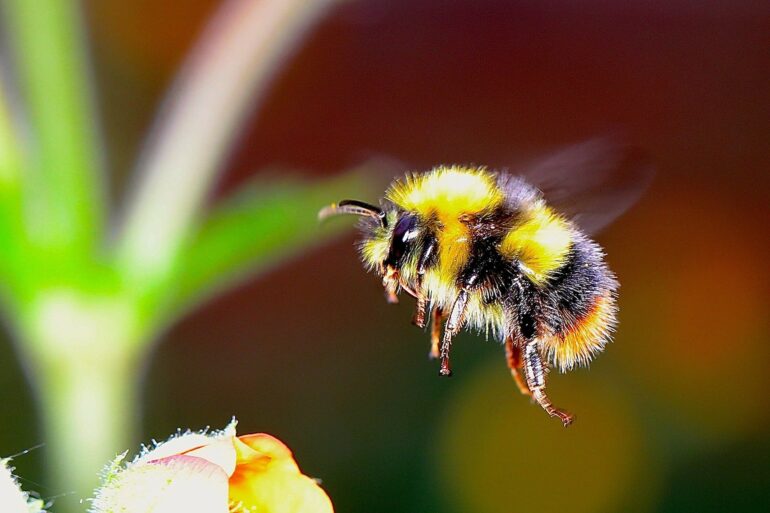Scientists from Imperial College London and the Natural History Museum today published two concurrent papers analyzing UK bumblebee populations.
The first investigated the morphology (body shapes) of bee specimens dating back to 1900. Using digital images, the group first investigated the asymmetry in bumblebee wings as an indicator of stress. High asymmetry (very differently shaped right and left wings) indicates the bees experienced stress during development—an external factor that affected their normal growth.
Studying four UK bumblebee species, the group found evidence for stress getting higher as the century progressed from its lowest point around 1925. Further analysis showed that each bee species displayed a consistently higher proxy of stress in the latter half of the century.
Learning from the past to predict the future
By taking the climate conditions during the year of collection—namely annual mean temperature and annual rainfall—the team found that in hotter and wetter years bees showed higher wing asymmetry. The study is published today in the Journal of Animal Ecology.
Author Aoife Cantwell-Jones, from the Department of Life Sciences (Silwood Park) at Imperial, says that “by using a proxy of stress visible on the bee’s external anatomy and caused by stress during development just days or weeks before, we can look to more accurately track factors placing populations under pressure through historic space and time.”
Author Dr. Andres Arce, now at the University of Suffolk, stated that their “goal is to better understand responses to specific environmental factors and learn from the past to predict the future. We hope to be able to forecast where and when bumblebees will be most at risk and target effective conservation action.”
Senior author Dr. Richard Gill, from the Department of Life Sciences (Silwood Park) at Imperial, says that “with hotter and wetter conditions predicted to place bumblebees under higher stress, the fact these conditions will become more frequent under climate change means bumblebees may be in for a rough time over the 21st century.”
DNA from single legs
As well as measuring the wing shapes of bees, in a second parallel study the team successfully sequenced the genomes of over a hundred bumblebee museum specimens dating back more than 130 years. In a pioneering advance, ancient DNA methods typically used for studying wooly mammoths and ancient humans, were for the first time used on an insect population.
Scientists from the Natural History Museum and the Earlham Institute quantified DNA preservation using just a single bee leg from each of the bees studied. From these developments, published today in Methods in Ecology & Evolution, the researchers can now look to determine how the reported stress may lead to genetic diversity loss.
In conjunction with providing a new reference genome, the team will now use this data to study how bee genomes have changed over time, gaining an understanding of how whole populations have adapted—or not—to changing environments.
The value of museum collections
Focusing on bumblebee collections, the team worked with curators from the Natural History Museum London, National Museums Scotland, Oxford University Museum of Natural History, World Museum Liverpool, and Tullie House Museum Carlisle.
Author Dr. Victoria Mullin, from the Natural History Museum, say that “museum insect collections offer an unparalleled opportunity to directly study how the genomes of populations and species have been affected by environmental changes through time. However, they are a finite resource and understanding how best to utilize them for genetic studies is important.”
Senior author Professor Ian Barnes, from the Natural History Museum, says that “one of the main problems with museum collections is that the quality of DNA can be very variable, making it difficult to predict which type of analyses we should do. We now have a much better idea about DNA preservation in insect collections, which is a massive boost to our ongoing work to understand the history and future of insect populations.”
Dr. Gill concluded that “these studies showcase the value of leveraging museums specimens to go back in time and unlock the past’s secrets. But what we have done is just the beginning, and by continuing our work with these vital public collections and collaborating with curators we can only discover more.
“This work was part of a Natural Environment Research Council-funded project and could not have been achieved without the commitment, hard work, and diligence of the museum curators, and our other collaborators. We are also grateful to BBSRC funds in supporting the generation of the bumblebee reference genome.”
More information:
Aoife Cantwell-Jones, et al, Signatures of increasing environmental stress in bumblebee wings over the past century: Insights from museum specimens, Journal of Animal Ecology (2022). doi.org/10.1111/1365-2656.13788
Victoria Mullin et al, First large-scale quantification study of DNA preservation in insects from natural history collections using genome-wide sequencing, Methods in Ecology & Evolution (2022). doi.org/10.1111/2041-210X.13945
Provided by
Natural History Museum
Citation:
Museum collections indicate bees increasingly stressed by changes in climate over the past 100 years (2022, August 18)



